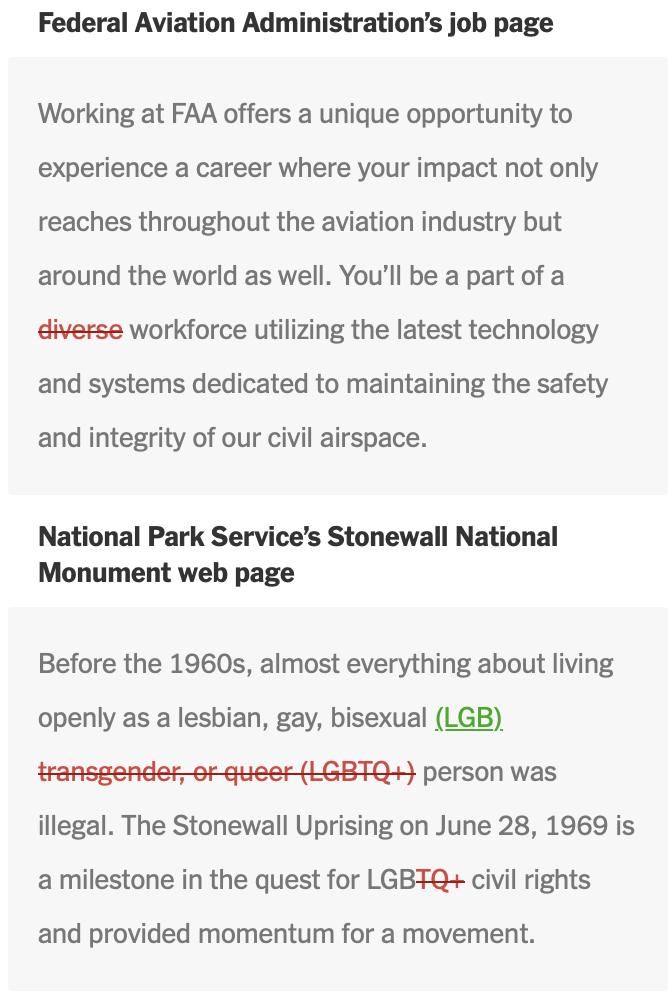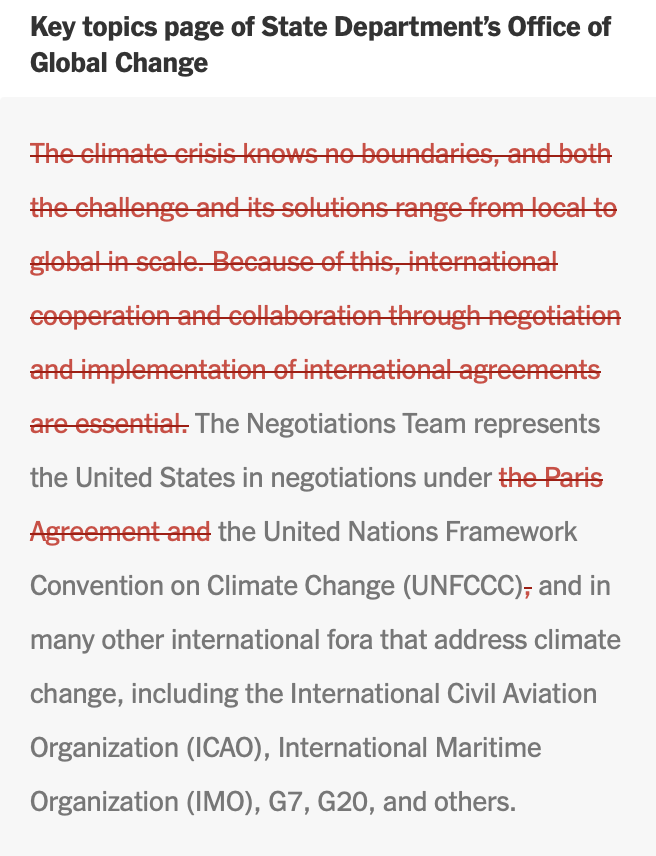These Words Are Disappearing in the New Trump Administration
Karen Yourish, Annie Daniel, Saurabh Datar, Isaac White and Lazaro Gamio
As President Trump seeks to purge the federal government of “woke” initiatives, agencies have flagged hundreds of words to limit or avoid, according to a compilation of government documents.
- accessible
- activism
- activists
- advocacy
- advocate
- advocates
- affirming care
- all-inclusive
- allyship
- anti-racism
- antiracist
- assigned at birth
- assigned female at birth
- assigned male at birth
- at risk
- barrier
- barriers
- belong
- bias
- biased
- biased toward
- biases
- biases towards
- biologically female
- biologically male
- BIPOC
- Black
- breastfeed + people
- breastfeed + person
- chestfeed + people
- chestfeed + person
- clean energy
- climate crisis
- climate science
- commercial sex worker
- community diversity
- community equity
- confirmation bias
- cultural competence
- cultural differences
- cultural heritage
- cultural sensitivity
- culturally appropriate
- culturally responsive
- DEI
- DEIA
- DEIAB
- DEIJ
- disabilities
- disability
- discriminated
- discrimination
- discriminatory
- disparity
- diverse
- diverse backgrounds
- diverse communities
- diverse community
- diverse group
- diverse groups
- diversified
- diversify
- diversifying
- diversity
- enhance the diversity
- enhancing diversity
- environmental quality
- equal opportunity
- equality
- equitable
- equitableness
- equity
- ethnicity
- excluded
- exclusion
- _expression_
- female
- females
- feminism
- fostering inclusivity
- GBV
- gender
- gender based
- gender based violence
- gender diversity
- gender identity
- gender ideology
- gender-affirming care
- genders
- Gulf of Mexico
- hate speech
- health disparity
- health equity
- hispanic minority
- historically
- identity
- immigrants
- implicit bias
- implicit biases
- inclusion
- inclusive
- inclusive leadership
- inclusiveness
- inclusivity
- increase diversity
- increase the diversity
- indigenous community
- inequalities
- inequality
- inequitable
- inequities
- inequity
- injustice
- institutional
- intersectional
- intersectionality
- key groups
- key people
- key populations
- Latinx
- LGBT
- LGBTQ
- marginalize
- marginalized
- men who have sex with men
- mental health
- minorities
- minority
- most risk
- MSM
- multicultural
- Mx
- Native American
- non-binary
- nonbinary
- oppression
- oppressive
- orientation
- people + uterus
- people-centered care
- person-centered
- person-centered care
- polarization
- political
- pollution
- pregnant people
- pregnant person
- pregnant persons
- prejudice
- privilege
- privileges
- promote diversity
- promoting diversity
- pronoun
- pronouns
- prostitute
- race
- race and ethnicity
- racial
- racial diversity
- racial identity
- racial inequality
- racial justice
- racially
- racism
- segregation
- sense of belonging
- sex
- sexual preferences
- sexuality
- social justice
- sociocultural
- socioeconomic
- status
- stereotype
- stereotypes
- systemic
- systemically
- they/them
- trans
- transgender
- transsexual
- trauma
- traumatic
- tribal
- unconscious bias
- underappreciated
- underprivileged
- underrepresentation
- underrepresented
- underserved
- undervalued
- victim
- victims
- vulnerable populations
- women
- women and underrepresented
Notes: Some terms listed with a plus sign represent combinations of words that, when used together, acknowledge transgender people, which is not in keeping with the current federal government’s position that there are only two, immutable sexes. Any term collected above was included on at least one agency’s list, which does not necessarily imply that other agencies are also discouraged from using it.
The above terms appeared in government memos, in official and unofficial agency guidance and in other documents viewed by The New York Times. Some ordered the removal of these words from public-facing websites, or ordered the elimination of other materials (including school curricula) in which they might be included.
In other cases, federal agency managers advised caution in the terms’ usage without instituting an outright ban. Additionally, the presence of some terms was used to automatically flag for review some grant proposals and contracts that could conflict with Mr. Trump’s executive orders.
The list is most likely incomplete. More agency memos may exist than those seen by New York Times reporters, and some directives are vague or suggest what language might be impermissible without flatly stating it.
All presidential administrations change the language used in official communications to reflect their own policies. It is within their prerogative, as are amendments to or the removal of web pages, which The Times has found has already happened thousands of times in this administration.
Still, the words and phrases listed here represent a marked — and remarkable — shift in the corpus of language being used both in the federal government’s corridors of power and among its rank and file. They are an unmistakable reflection of this administration’s priorities.
For example, the Trump administration has frequently frameddiversity, equity and inclusion efforts as being inherently at odds with what it has identified as “merit,” and it has argued that these initiatives have resulted in the elevation of unqualified or undeserving people. That rhetorical strategy — with its baked-in assumption of a lack of capacity in people of color, women, the disabled and other marginalized groups — has been criticized as discriminatory.
Indeed, in some cases, guidance against a term’s usage has arrived alongside directives intended to eliminate the concept itself. Federal diversity, equity and inclusion initiatives are one example; the Gulf of Mexico is a very different one.
That shift is already apparent on hundreds of federal government websites. A New York Times analysis of pages on federal agency websites, before and after Mr. Trump took office, found that more than 250 contained evidence of deletions or amendments to words included in the above list.
Here are some notable examples. Words that have been removed are shown in red with strikethroughs, and words that have been added are in green with underlines.



The total number of web pages identified by The Times as having changed is an undercount. The analysis involved searching for changes on more than 5,000 total pages, but it did not capture the entire universe of the federal government’s web presence. In addition, the pages were captured for comparison in early February, and more changes may have been made between then and now.
The president and some of his closest advisers, including Elon Musk, have frequently portrayed themselves as champions of free speech. One of the executive orders Mr. Trump signed on his first day back in office decried what it described as a pressure campaign by the Biden administration to stifle First Amendment rights “in a manner that advanced the Government’s preferred narrative about significant matters of public debate,” by way of putting pressure on tech platforms. “Government censorship of speech is intolerable in a free society,” it continued.
Indeed, the office of the presidency carries with it a tremendous power to drive the discourse. But the pattern of vanishing words established here suggests Mr. Trump and his administration may be more interested in chilling the national conversation — at least when it comes to their own disfavored topics — than in expanding it.
Methodology: To find federal web pages with changes that reflected the list of discouraged words, Times journalists extracted the text from over 5,000 snapshots of federal web pages — landing pages of major agency and department websites, as well as pages to which they linked — from before and after Mr. Trump’s inauguration. We employed a large-language model to search the extracted text for changes, specifically looking for words highlighted by agencies as no longer in use. The large-language model helped us identify changes that were thematically similar to the list of discouraged words. It also surfaced changes made to pages in languages other than English. We then manually reviewed each passage to determine the meaning and relevance of each change.
Reporting was contributed by Julian Barnes, Christopher Flavelle, Dylan Freedman, Apoorva Mandavilli, Katrina Miller and Nicholas Nehamas.